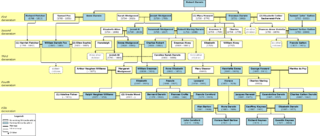
The Darwin–Wedgwood family are members of two connected families, each noted for particular prominent 18th-century figures: Erasmus Darwin, a physician and natural philosopher, and Josiah Wedgwood, a noted potter and founder of the eponymous Wedgwood and Sons pottery company. The Darwin and Wedgwood families were on friendly terms for much of their history and members intermarried, notably Charles Darwin, who married Emma Wedgwood.

An ollam or ollamh, plural ollomain, in early Irish literature, was a master in a particular trade or skill.

The O'Donnell dynasty were the dominant Irish clan of the kingdom of Tyrconnell in Ulster in the north of medieval and early modern Ireland.

Inis Cathaigh or Scattery Island is an island in the Shannon Estuary, Ireland, off the coast of Kilrush, County Clare. The island is home to a lighthouse, a ruined monastery associated with Saints Senan and Canir, an Irish round tower and the remains of an artillery battery. The last residents left in 1969. Most of the island is now owned by the Office of Public Works, who run a small visitor centre and carry out repairs and maintenance on the island; it was bought by Dúchas in 1991.The Irish name Inis Cathaigh was formerly anglicised Iniscathy, which later became Iniscattery and finally Scattery.
Senán mac Geircinn is a prominent Munster saint in Irish tradition, founder of Inis Cathaigh and patron of the Corco Baiscinn and the Uí Fhidgeinte. He is listed among the Twelve Apostles of Ireland.

Sir Francis Sacheverel Darwin was a physician and traveller who was knighted by King George IV. Francis Galton and Charles Darwin were his nephews.
Saint Felim, an Irish Christian hermit and priest, was born, probably in Kiennacta Breagh, County Meath in the mid sixth century.
Eochaid mac Colla, better known as Saint Dallán or Dallán Forgaill, was an early Christian Irish poet and saint known as the writer of the "Amra Coluim Chille" and, traditionally, "Rop Tú Mo Baile".
Saint Diarmaid the Just was a Catholic abbot of Inis Clothrann (Inchcleraun), Lough Ree, County Longford and of Faughalstown, County Westmeath and a famous Irish confessor of the late-sixth century.
Conainne, also known as Dachonna, was an Irish missionary and saint. The Irish terms of endearment, mo and do, were regularly added to the names of Irish saints and secular people, hence the origin of her diminutive pseudonym, Dachonna.
Senchán Torpéist was a Gaelic-Irish poet.
The Ollamh Érenn or Chief Ollam of Ireland was a professional title of Gaelic Ireland.
Dubthach maccu Lugair, is a legendary Irish poet and lawyer who supposedly lived at the time of St Patrick's mission in Ireland and in the reign of Lóegaire mac Néill, high-king of Ireland, to which Dubthach served as Chief Poet and Brehon. In contrast to the king and his druids, he is said to have readily accepted the new religion. This event has played a major part in Hiberno-Latin and Irish sources as representing the integration of native Irish learning with the Christian faith.
Saint Caillin was an Irish medieval saint and monastic founder. His Feast day is celebrated on 13 November. The patron saint of Fenagh, County Leitrim, Caillin was born in the 6th century and founded a monastic settlement at Fenagh. His history was given in the Old Book of Fenagh. The Annals of the Four Masters mention of him living in 464 is based on the very late unreliable 16th century Book of Fenagh. All his siblings lived in the second half of the 6th century so it is likely Caillín lived at the same time. This date is also supported by his position in the Irish genealogies and by the Life of Saint Mogue, who was taught by Caillín.
Mainchín mac Colláin was an Irish saint in Corran who is supposed to have flourished in the late 5th or 6th century.
Saint Femia was an Irish Christian saint, a sister of Saint Felim of Kilmore and Saint Daig of Inniskeen.
Saint Daig was an Irish Christian bishop and confessor of Inis-Caoin-Deagha, who lived towards the end of the 6th century. His name in Gaelic means "A great flame" and he was probably named after his mother Deighe.
Saint Gabhran was a 5th-century Irish saint.

Group Captain Nicolas Tindal-Carill-Worsley RAF, was a bomber pilot during the Second World War who helped plan and execute the Great Escape from Stalag Luft III, where he was imprisoned between 1940 and 1945.
Laraghbryan is the site of an old monastic settlement, cemetery and ruined church, 1 kilometre (0.62 mi) west of Maynooth, County Kildare, Ireland.





